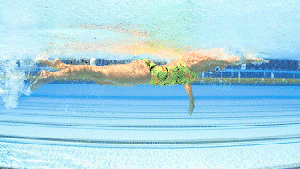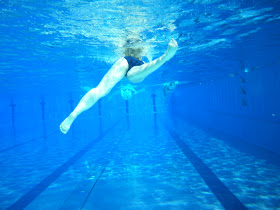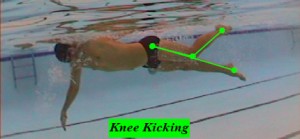
I swim with a talented triathlete who is not a great swimmer. Well, that’s half true; he always torches me when we do pull sets. But throw the kick into the mix and the ball game has changed. A familiar story, he comes from a running background and has learned through observation that triathlons are won on the run. He noticed that the athletes who kick hard in the swim tend to be the same ones who he passes on the run, as they bonk out of the race.
As a previously self-coached athlete, I understand his logic. In fact, I believed exactly that when I first started, so I experimented (miserably) with Total Immersion. This athlete is not a newbie; in fact, I think we have been in the game for the same amount of time now. Although the competitive side of me wants to race him head-to-head, we are in the same club and I really want him to reach his potential. If he were to unleash his swim kick, I think he’ll find more success.
His kick looks something like this: Very wide, little propulsion (only about a 2 beat kick), hips sink and little to no splashing.
Here are my problems with this:
1) A wide kick is doing more harm than good. If your leg pushes past your slip stream, then you incur unnecessary water resistance. If you keep the kick tight, then you don’t have to work harder to push past the extra water you are now coming into contact with. Look how much extra water (read: resistance) this swimmer comes in contact with:

2) Kicking with the knee makes for a shorter lever to gain propulsion from. I have seen people kick extremely hard from their knee, barely move forward and tire out quickly. Kicking from the knee engages your hamstrings too much, as you pull your foot back hinged at the knee. Using your hamstrings in the swim will surely wipe them out for the run. With a mostly straight knee, you start your kick from the hip, tapping that to generates a lot more power and then you use a lever that is twice as long. It’s like lifting something with a wheel barrel (kicking from hips) instead of lifting it with your hands/biceps (kicking from knees):

Versus

3) The slow kick cadence causes there to be a dead spot in between arm pulls. Every time there is a delay, your legs drop and it slows you down, taking more energy to get back up to speed with the next pull. “An object in motion tends to stay in motion”, Sir Isaac Newton describing his Law of Inertia. Kick faster (but smaller) to eliminate this dead spot and keep your motion going forward. Use the six beat kick, or simply, the flutter kick, to bridge the dead spot gap and stay stream lined. The dead spot can be eliminated with a two beat kick, but practicing the flutter will train your neuromuscluar system on where your body position should be.
Balance: Correcting these issues will help minimize your exposure to the oncoming water. You will be in a better streamlined position, so minimizing the amount of drag you create will ease your work load. Balance in the water often starts with the kick. My favorite way to work on balance is by kicking with a snorkel. My favorite method to work on the kick is with the snorkel. Using a kickboard to do your kick-sets reinforces improper balance, so a snorkel kills two birds with one stone. Good balance starts with the kick and makes pulling easier.
If you already have great balance without the kick, then you are fortunate. That still does not give you the excuse to kick wide or kick exclusively from your knees. But in a long course race, especially if you get the added buoyancy from a wetsuit and maybe some salt water, then there may be a race plan that includes holding back on the kick. This usually does not mean the entire race will be executed with an easy kick. There will be times when you’ll need to kick it into high gear to hang onto a draft or tactically maneuver past a turn buoy. For this reason alone, you need to practice a proper kick. It is better to practice a good kick so it’s there when you need it rather than ignore it altogether. After all, perfect practice makes perfect. For those of us with a run background living in Texas, where we swim in warm, saltless (and dirty) lakes, that goes without saying; we really need to stay on top of our kick.
This athlete is just fast when it comes to biking and running. Since I also have a bike and run background, I can relate to the feeling of getting to T1 with the majority of the bikes already on the road. I know what the uphill battle is like, always looking for the next competitor to pick off. But if I want to get to the next level, I need to get out of the water with the lead or second lead pack. My talented club mate; even more-so. He’s even closer than me to the next level. To do it, swim fitness is a huge part of the equation, but having the fitness will get you the gift of drafting with the top leaders. Getting out of the water with them lets you draft off cyclists who are closer to your pace. Rather than working through the field and jumping on an occasional draft before moving on to the next one, you are already with the big dogs. Those in front of you are the ones who you are really racing against, so you can make better judgment calls and really race instead of just Time Trialing. Finally, when you get off of the bike, you get to run with those who are fighting for the podium! If you could not quite hold the bike pace, your chance at redemption is real, because you are that much closer to them. By the time you approach the finish line, you know exactly where you stand.
Direct message to my friend: I want you to succeed! You already put in the time training, made significant sacrifices and battled back through crazy adversity. Become a complete triathlete and nail down that kick! At a minimum, practice it. When your race plan calls for it, you will have it in your tool box with confidence. If you agree… and you are in a base period*… your next step is to purchase a snorkel and a swim band.
Happy swimming!
Tri Coach Mark
@ExclaimedMark
*In other words, don’t experiment too close to an A-race!